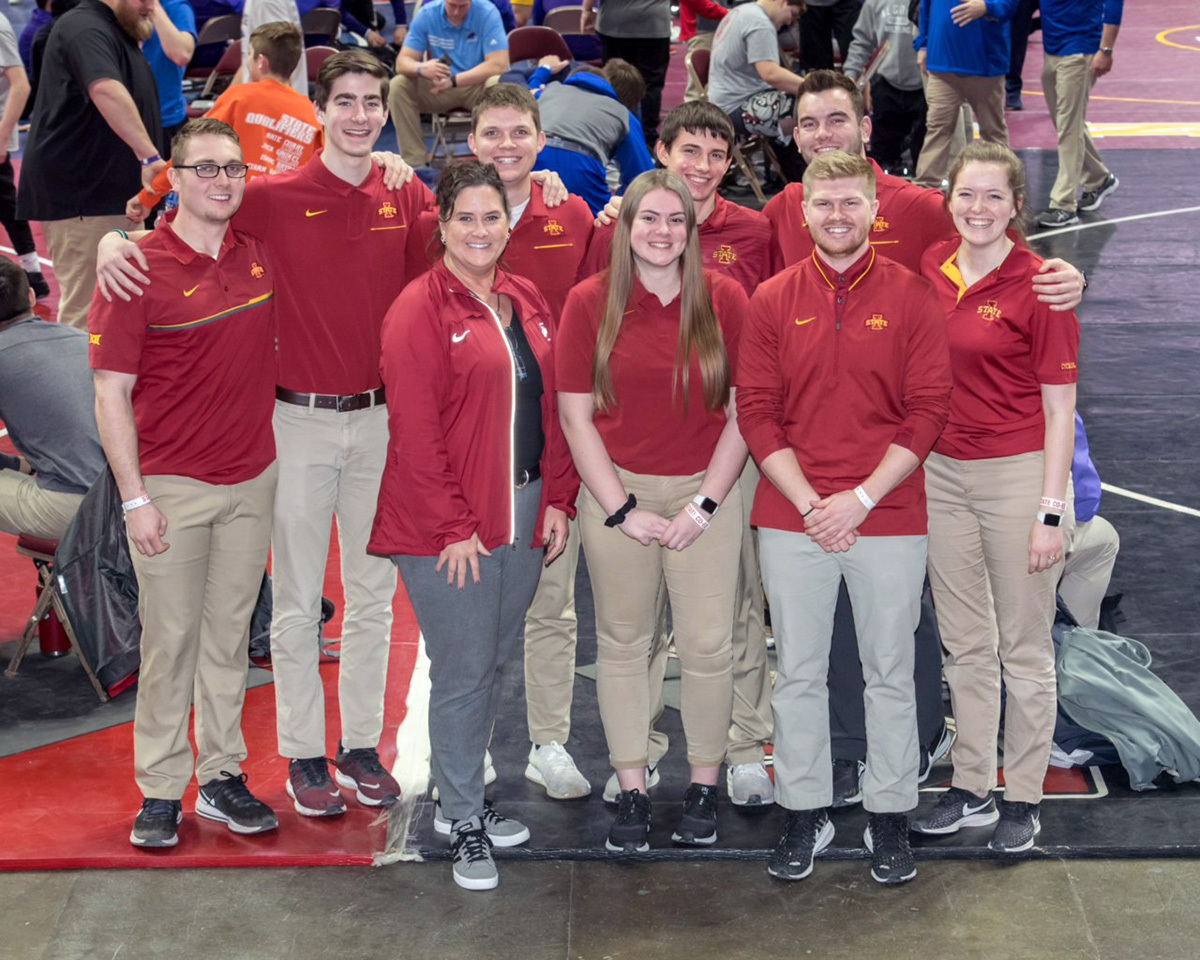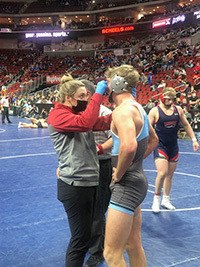Connection with tourney shines light on Iowa State athletic trainers
Author: Jeff Budlong
This is an archived story. The content, links and information may have changed since the publication date.
Author: Jeff Budlong

Iowa State athletic trainers during the 2020 state wrestling tournament. Front (left to right) Mary Meier, Katelyn Nelson, Adam Sibert and Abigail DeWitt Johnson. Back row, Levi Brouse, Hudson Kopp, Jordan Graham, Parker Eley and Derrik Kerns. Photos courtesy of Mary Meier.
Next year's high school state wrestling tournament carries an increased level of importance, and not just because a record four wrestlers could win their fourth state title. It also marks the 50th year Iowa State athletic trainers will provide their services at one of the biggest high school events in the state.
"Frank Randall was the head athletic trainer at ISU back then, and there were not many athletic trainers working in the state," associate athletics director for sports medicine Mark Coberley said. "He was always pushing to get an understanding of what athletic trainers could do to the public, and he set up outreach programs where Iowa State provided athletic trainers to different events."
Keeping athletes healthy is always a difficult job. But the challenges have only increased as the COVID-19 pandemic has made close contact with patients more difficult. The work and training continues for students at Iowa State.
That has grown over the years to between 25-35 Iowa State students putting skills learned in a classroom into practice in a high-intensity environment that helps the four-day February tournament run safely.
"We are there, but we try to let our students do everything and just guide them," said kinesiology clinical associate professor Mary Meier, who is in her third year directing the athletic trainers at the state tournament. "It is a real thing that is happening, not something they are reading in a book."
It also shines a light on the university as the trainers -- clad in Iowa State shirts -- are thanked for their efforts daily during a session.
"We are fortunate at Iowa State that they have asked us to coordinate that care," said Coberley, who worked the tournament as a student in the 1980s.
An event as big as state wrestling involves plenty of planning and requires student trainers to understand the behind-the-scenes organizational effort. They must:
Students take courses on evaluation of injuries, rehabilitation, dealing with emergencies, and prevention and care before staffing the tournament.
"They have coursework they have taken, but before each session we have a five- to 10-minute discussion going over their mat, the supplies and how to handle some situations," Meier said. "It is a crash course."
Student trainers are supervised by certified athletic trainers, but Meier said they perform most of the duties on their own. They also coordinate care with two physicians at each session.
The chance to see and have a hand in planning a large event serves the trainers well long after graduation as they apply that knowledge in future jobs, Meier said.
Internships, summer jobs and trips to other countries are vital learning tools for students across campus, but rarely is knowledge gained in a classroom used and expanded on in such a condensed time frame.

Student athletic trainer Grace Quinn helps a wrestler stop bleeding during the 2021 state wrestling tournament.
Meier said athletic trainers typically spine board one to two athletes during the tournament, and deal with bloody noses or cut lips on a nearly match-by-match basis. This year's tournament saw a trainer treat a dislocated elbow on the mat.
"The trainers also are working with a time limit because you only get so much time to stop a bloody nose," Meier said. "Our kids get excited working it because there is an adrenaline rush knowing you don't have all the time."
Students evaluate, communicate and execute without the direct assistance of an instructor. The trainers rotate through different sessions, but it can be a grueling assignment as Meier spent 59 hours at Wells Fargo Arena for this year's tournament.
Iowa State doesn't just provide an athletic trainer on eight mats. It also staffs the athletic training room where more serious injuries are evaluated and coaches and athletes come to seek advice.
"We have quite a few wrestling coaches who come into the training room and have us look at their athletes with injuries they may have had for four, six, nine months," Meier said.
Coaches, especially from schools that don't have their own athletic trainers, use ISU students to get opinions on care. Trainers provide advice about what questions to ask and kinds of care to seek when wrestlers return home. Those interactions could lead ISU to develop a telehealth option in the future, Meier said. It also tests students' communication skills relaying different information to an athlete, coach and parent.
"We really hammer home with our students that you have to make eye contact, use strong verbal communication skills and be able to handle a difficult conversation," Meier said.
Exposure at events like the state wrestling tournament is fruitful for the athletic training program, a program that places graduates with numerous professional sports teams. Students have the opportunity to meet certified athletic trainers traveling with teams and interact with high school officials.
"There are a lot of networking opportunities and sometimes it opens up a job opportunity for them," Meier said. "They meet a high school principal or superintendent and develop a positive relationship that proves to be beneficial later."
The Special Olympics also uses trainers during the three-day summer event held on campus.
"The students need to be exposed to a nontraditional type of athlete," Meier said.